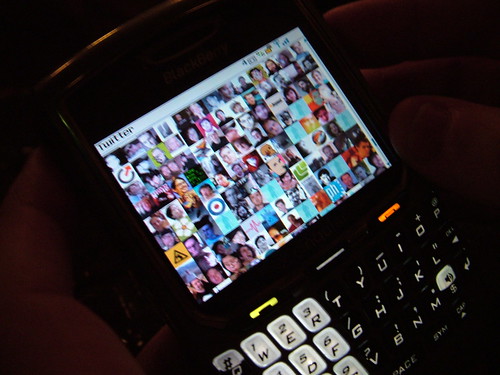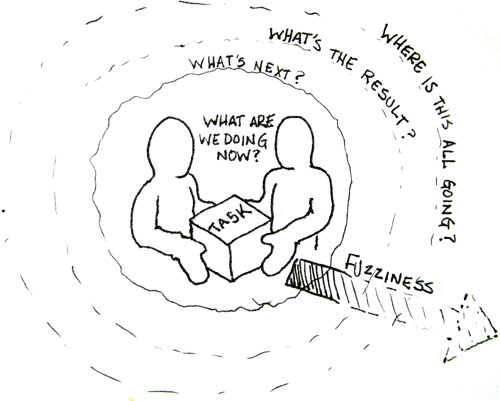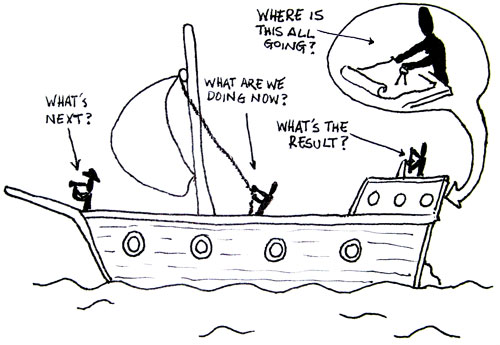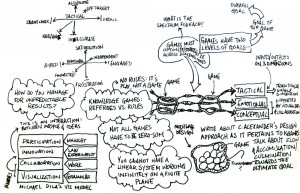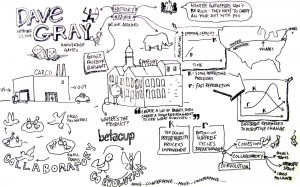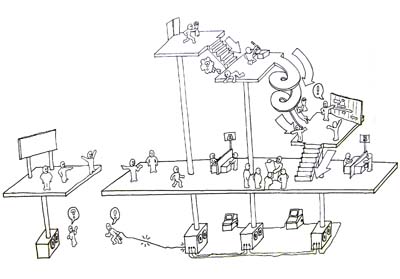
version 0 of the model in my head...
More dissection of the SXSW conference and its social/cultural reverberations has helped me crystallize some thinking on sharing in the context of large gatherings.
Conferences, as a confluence of intellectual inputs and people, represent huge potential for learning and knowledge creation, but also represent an equal amount of lost opportunity and knowledge dissipation. The perennial question is; how do we capture both the ideas and the energy that people feel at these gatherings and sustain them?
I’ve been looking into this question for some time, both with regards to ongoing projects that I’ve been doing, but also in relation to upcoming projects which will require a scaling of attention and engagement on a much larger scale.
I have a model emerging in my head about this, which I think contextualizes some of the thoughts I had on the scattershot sharing from SXSW last week, but also much of the work that we’ve done at Davos.
The first axis I imagine is between inclusiveness and exclusivity. Inclusive gatherings are open to all, but also have no secrets, and thus can open the knowledge created to the world. Exclusive events can either be exclusive on the basis of attendance (only certain individuals may attend) or content (the knowledge being shared is private), or both.
All gatherings are, to some degree, implicitly exclusive; there are those who have attended, and those who haven’t. Others are explicitly exclusive; you’re not there because you weren’t invited.
Taking Davos as an example, it is explicitly exclusive, as attendees are by invitation only, and must fall within certain criteria to be invited. SXSW, on the other hand, is largely inclusive, with only implicit exclusivity; those who could make it, and those who could not.
Sharing takes a different tone in the two cases. For Davos, there is both a public and a private program, with predictable limitations on what information can be shared attached to each. But from a broader perspective, sharing at Davos is more a question of transparency than of knowledge creation; the outside world is concerned that issues of importance are being discussed there by the many public figures who attend, and thus there is a need to have some sense of what goes on within the conference.
In the case of SXSW, sharing can be as open as the registration process; there are no secrets and anyone is free to share any of the information or insights gleaned from the conference.
An interesting hybrid of the two is TED; the conferences are explicitly exclusive, as only a curated set of members may attend. The knowledge shared at the conference, however, is shared widely, and, indeed, the conference acts as a platform for sharing great ideas.
This brings me to the sharing itself. To me, the strategy for sharing and engagement must be driven by 1.) the type of information being shared, 2.) the value of sharing, and 3.) the intent of sharing.
1.) Information Type: Is it an idea? A concept? A business model? A story? Or is it the experience itself? While Davos might have press conferences, TED releases “TED Talks”, videos of profession-leading speakers expressing their ideas in succinct, well produced talks. Much of this is a matter of defining what format would help give meaning to the experience for those who were not there. At SXSW last week, keynote speeches were visually captured and the notes were assembled on a microsite for sharing by graphic facilitation group ImageThink, giving a chance for the outside world to get a flavor for what was happening at the conference.
2.) Value: Why even share? What value does the shared element hold for people receiving it? I personally love the TED tagline “Ideas Worth Spreading”; it’s an acknowledgment of the inherent value of good ideas to humanity. But also shrewdly built into their strategy is that the openness of their content sharing (coupled with its legendary quality) helps to fuel the sense of exclusivity; the cachet of their brand and therefore, of attendance, is only increased by their openness with their information.
3.) Intent: A nuance, perhaps, but an important one; what do you want to get out of sharing? Is it to build community? To have others build on the ideas? To contribute to collective knowledge? To drive more conference attendance?
All of this, to my mind, is the foundation of thinking about what and how to share through social channels in a conference setting. Awareness of the balance between the elements, and most of all, the intent and purpose. Many were miffed at the social sharing coming out of SXSW last week because it appealed only to the implicit exclusivity of being there, as opposed to some broader purpose (as evidenced by the tweet “and…i’m eating a taco next to danny devito”). The ImageThink strategy was a refreshing reprieve from that; content focused summaries on their site actually fueled inclusiveness, instead of exclusivity.
At Davos, the tension is often between wanting to share emergent ideas that are of interest, balanced with the need for privacy that makes many of the conversations that happen there possible. As a platform for facilitating dialogue between stakeholders that can’t happen elsewhere, the need to create a “safe space” can often be undermined by a sense of exposure.
A challenge that I’m currently working on is to use a series of conferences as a platform for collective knowledge creation to be built on and shared over time by a much broader community. While visualization and social media will be central to the effort, the challenge of driving inclusiveness will, I think be the most interesting part. I’d welcome examples of conferences that have truly driven broader participation beyond the immediate attendees.



